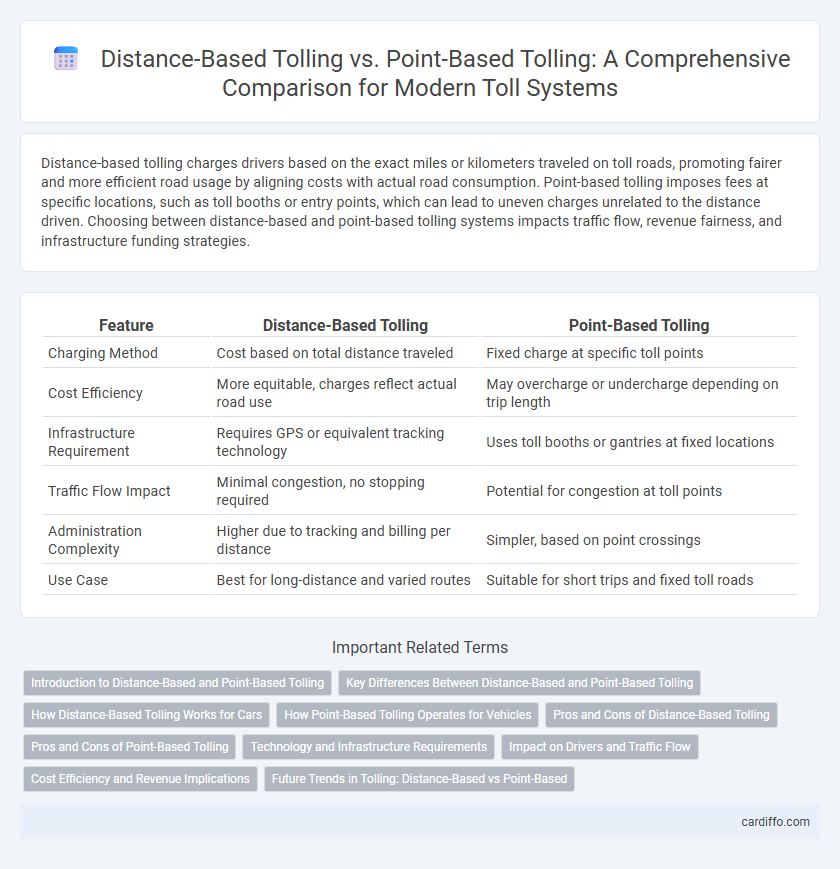Distance-based tolling charges drivers based on the exact miles or kilometers traveled on toll roads, promoting fairer and more efficient road usage by aligning costs with actual road consumption. Point-based tolling imposes fees at specific locations, such as toll booths or entry points, which can lead to uneven charges unrelated to the distance driven. Choosing between distance-based and point-based tolling systems impacts traffic flow, revenue fairness, and infrastructure funding strategies.
Table of Comparison
| Feature | Distance-Based Tolling | Point-Based Tolling |
|---|---|---|
| Charging Method | Cost based on total distance traveled | Fixed charge at specific toll points |
| Cost Efficiency | More equitable, charges reflect actual road use | May overcharge or undercharge depending on trip length |
| Infrastructure Requirement | Requires GPS or equivalent tracking technology | Uses toll booths or gantries at fixed locations |
| Traffic Flow Impact | Minimal congestion, no stopping required | Potential for congestion at toll points |
| Administration Complexity | Higher due to tracking and billing per distance | Simpler, based on point crossings |
| Use Case | Best for long-distance and varied routes | Suitable for short trips and fixed toll roads |
Introduction to Distance-Based and Point-Based Tolling
Distance-based tolling charges drivers according to the actual distance traveled on toll roads, providing a fair and usage-based pricing model that encourages efficient road use and reduces congestion. Point-based tolling imposes fees at specific toll points, which can simplify administration but may lead to uneven charges depending on entry and exit locations. Both systems aim to optimize revenue collection and traffic management, but distance-based tolling offers more precise cost allocation linked to road usage.
Key Differences Between Distance-Based and Point-Based Tolling
Distance-based tolling charges drivers based on the total distance traveled within a tolled area, promoting equitable road usage fees, while point-based tolling imposes charges at specific toll plazas or checkpoints. Distance-based systems utilize GPS or mileage tracking for seamless billing, offering flexibility and reducing congestion at toll points, whereas point-based tolling depends on physical infrastructure like toll booths or gantries. Key differences include billing accuracy, traffic flow impact, infrastructure costs, and scalability, with distance-based methods favoring dynamic pricing models suited for urban congestion management.
How Distance-Based Tolling Works for Cars
Distance-based tolling for cars calculates fees based on the actual miles traveled within toll zones, using GPS technology or electronic transponders to track vehicle movement. This system charges drivers proportionally, promoting fairness and reducing congestion by encouraging shorter trips and efficient route choices. By accurately measuring distance, it eliminates traditional toll booths, streamlining traffic flow and minimizing delays on highways.
How Point-Based Tolling Operates for Vehicles
Point-based tolling operates by charging vehicles at specific toll points along a roadway, where electronic sensors or toll booths detect and record vehicle passage. Vehicles are typically identified through transponders or license plate recognition systems, enabling automated fee collection without requiring a continuous tracking process. This method simplifies toll calculation by applying fixed fees per toll plaza passed, facilitating efficient traffic flow and reducing congestion compared to distance-based systems.
Pros and Cons of Distance-Based Tolling
Distance-based tolling charges drivers based on the exact distance traveled, promoting fairer road usage fees and potentially reducing congestion by encouraging shorter trips or alternative routes. It requires sophisticated GPS technology and infrastructure, raising concerns about privacy, high implementation costs, and complex billing systems compared to point-based tolling. Distance-based tolling improves revenue accuracy and traffic management but demands advanced data processing and can face resistance from users concerned about data security.
Pros and Cons of Point-Based Tolling
Point-based tolling charges drivers at specific locations such as bridges, tunnels, or highway entry and exit points, offering a straightforward and easily understood system for users. This method simplifies revenue collection and reduces technological infrastructure costs compared to continuous distance-based tolling, but it can lead to congestion at toll plazas and may not fairly reflect actual road usage. However, point-based tolling often lacks the precision in charging for road wear and traffic impact, potentially resulting in inefficiencies and inequities in toll distribution.
Technology and Infrastructure Requirements
Distance-based tolling relies on GPS or RFID technology integrated into vehicles and roadside units, requiring advanced satellite positioning systems and continuous data communication infrastructure. Point-based tolling depends on fixed toll plazas equipped with electronic toll collection (ETC) systems such as ANPR cameras or transponder readers, demanding less complex but high-capacity roadside hardware. Implementing distance-based systems involves substantial investment in telematics and real-time data processing platforms, whereas point-based solutions focus on maintaining physical toll booths and associated network connectivity.
Impact on Drivers and Traffic Flow
Distance-based tolling charges drivers based on the exact miles traveled, encouraging efficient route choices and potentially reducing congestion by distributing traffic more evenly across road networks. Point-based tolling, which charges at specific locations such as toll plazas or congestion zones, can create localized bottlenecks and increase wait times during peak hours. The dynamic nature of distance-based tolling promotes smoother traffic flow and offers greater fairness by aligning fees with road usage intensity.
Cost Efficiency and Revenue Implications
Distance-based tolling enhances cost efficiency by charging drivers based on actual road usage, resulting in fairer toll distribution and reduced congestion over longer routes. This system generates more consistent revenue streams by correlating tolls directly with distance traveled, minimizing revenue leakage associated with point-based tolling. Conversely, point-based tolling simplifies implementation but may lead to revenue volatility and inequitable cost burdens due to fixed charges at specific locations regardless of total distance traveled.
Future Trends in Tolling: Distance-Based vs Point-Based
Distance-based tolling employs GPS or sensor technologies to charge drivers according to the exact miles traveled, promoting fairness and efficient road usage in smart transportation systems. Point-based tolling, charging vehicles at specific entry or exit locations, remains simpler but may generate congestion at toll plazas. Emerging trends favor distance-based tolling due to advancements in connected vehicle infrastructure, enabling dynamic toll pricing aligned with traffic patterns and environmental goals.
Distance-based tolling vs point-based tolling Infographic

 cardiffo.com
cardiffo.com